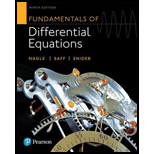
Fundamentals of Differential Equations (9th Edition)
9th Edition
ISBN: 9780321977069
Author: R. Kent Nagle, Edward B. Saff, Arthur David Snider
Publisher: PEARSON
expand_more
expand_more
format_list_bulleted
Concept explainers
Expert Solution & Answer
Want to see the full answer?
Check out a sample textbook solution
Students have asked these similar questions
Please show all steps and write out the answer instead of typing it out, thanks
PROBLEM 1: A 12-lb rod ABC is impacted by a 2-lb object DE as shown. The
object embeds into the end of the rod at point C, determine immediately after the
impact
(a) the angular velocity of the rod ABC,
(b) the angular acceleration of the rod ABC,
A
2
B
Unit: ft
(c) the components of the reaction at B.
12
Assume that the object and the rod move as a single body after the impact.
Vo
= 35 ft/s
C
E
D
6
Please answer both questions clearly thanks
Chapter 7 Solutions
Fundamentals of Differential Equations (9th Edition)
Ch. 7.2 - Prob. 1ECh. 7.2 - Prob. 2ECh. 7.2 - Prob. 20ECh. 7.2 - Prob. 28ECh. 7.2 - Prob. 29ECh. 7.4 - In Problems 110, determine the inverse Laplace...Ch. 7.4 - Prob. 3ECh. 7.4 - Prob. 5ECh. 7.4 - Prob. 7ECh. 7.4 - Prob. 9E
Ch. 7.4 - Prob. 11ECh. 7.4 - Prob. 13ECh. 7.4 - In Problems 1120, determine the partial fraction...Ch. 7.4 - Prob. 17ECh. 7.4 - Prob. 19ECh. 7.4 - Prob. 21ECh. 7.4 - Prob. 23ECh. 7.4 - Prob. 25ECh. 7.5 - Prob. 1ECh. 7.5 - Prob. 3ECh. 7.5 - Prob. 5ECh. 7.5 - Prob. 7ECh. 7.5 - Prob. 9ECh. 7.5 - Prob. 11ECh. 7.5 - Prob. 13ECh. 7.5 - Prob. 25ECh. 7.5 - Prob. 27ECh. 7.5 - Prob. 33ECh. 7.5 - Prob. 35ECh. 7.6 - In Problems 14, sketch the graph of the given...Ch. 7.6 - Prob. 3ECh. 7.6 - In Problems 510, express the given function using...Ch. 7.6 - Prob. 7ECh. 7.6 - Prob. 11ECh. 7.6 - Prob. 17ECh. 7.6 - Prob. 19ECh. 7.8 - Prob. 1ECh. 7.8 - Prob. 3ECh. 7.8 - Prob. 5ECh. 7.8 - Prob. 23ECh. 7.10 - In Problems 119, use the method of Laplace...Ch. 7.10 - Prob. 3ECh. 7.10 - Prob. 5ECh. 7.10 - Prob. 7ECh. 7.10 - Prob. 9ECh. 7.10 - Prob. 11ECh. 7.10 - Prob. 13ECh. 7.10 - Prob. 15ECh. 7.10 - Prob. 17ECh. 7.10 - Prob. 19E
Knowledge Booster
Learn more about
Need a deep-dive on the concept behind this application? Look no further. Learn more about this topic, advanced-math and related others by exploring similar questions and additional content below.Similar questions
- PROBLEM 2: A baseball catcher includes a 6-kg rod with a small net of negligible mass at point B. A spring of unstretched length 0.3 m is attached to the midpoint of bar AB at one end and to stationary point D at the other. A stopper at point E keeps the catcher in the vertical position before the pitch. Knowing the catcher just barely rotates when it catches a fastball of mass 0.18 kg, determine the required spring constant of the spring. Given = 1.5 m. Bonus: Develop a MATLAB program to solve for this problem. v₁ = 40 m/s Unit: m 1 B L E A D www wwwwwww -L-arrow_forwardQ5: Discuss the stability critical point of the ODEs x + (*)² + 2x² = 2 and draw the phase portrait. (10M)arrow_forwardNo chatgpt pls will upvotearrow_forward
- Q/By using Hart man theorem study the Stability of the critical points and draw the phase portrait of the system:- X = -4x+2xy - 8 y° = 4y² X2arrow_forwardФ sketch stability x= -4x + 2xy - 8 y° = 4 y 2 - x² чуг.arrow_forward2 Q/Given H (x,y) = x² + y² - y² Find the Hamiltonian System and prove it is first integral-arrow_forward
- Q2) A: Find the region where ODEs has no limit cycle: x = y + x³ y=x+y+y³ 6arrow_forwardQ3)A: Given H(x,y)=x2-x+ y²as a first integral of an ODEs, find this ODES corresponding to H(x,y) and show the phase portrait by using Hartman theorem and by drawing graph of H(x,y)-e. Discuss the stability of critical points of the corresponding ODEs.arrow_forwardQ/ Write Example is First integral but not Conservation system.arrow_forward
- Q/ solve the system X° = -4X +2XY-8 y°= 2 4y² - x2arrow_forwardQ4: Discuss the stability critical point of the ODES x + sin(x) = 0 and draw phase portrait.arrow_forwardUsing Karnaugh maps and Gray coding, reduce the following circuit represented as a table and write the final circuit in simplest form (first in terms of number of gates then in terms of fan-in of those gates). HINT: Pay closeattention to both the 1’s and the 0’s of the function.arrow_forward
arrow_back_ios
SEE MORE QUESTIONS
arrow_forward_ios
Recommended textbooks for you
 College Algebra (MindTap Course List)AlgebraISBN:9781305652231Author:R. David Gustafson, Jeff HughesPublisher:Cengage Learning
College Algebra (MindTap Course List)AlgebraISBN:9781305652231Author:R. David Gustafson, Jeff HughesPublisher:Cengage Learning

College Algebra (MindTap Course List)
Algebra
ISBN:9781305652231
Author:R. David Gustafson, Jeff Hughes
Publisher:Cengage Learning
Introduction to Algebra: Using Variables; Author: Professor Dave Explains;https://www.youtube.com/watch?v=WZdZhuUSmpM;License: Standard YouTube License, CC-BY